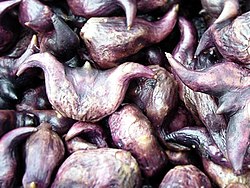Water caltrop
| Habit | aquatic
| |
|---|---|---|
| Lifespan: | ⌛ | perennial |
| Water: | ◍ | wet |
|---|---|---|
| Features: | ✓ | edible |
|
Trapa > |
The water caltrop , water chestnut or Singhara is either of two species of the genus Trapa: Trapa natans and Trapa bicornis. Both species are floating annual aquatic plants, growing in slow-moving water up to 5 meters deep, native to warm temperate parts of Eurasia and Africa. They bear ornately shaped fruits that resemble the head of a bull, each containing a single very large starchy seed. It has been cultivated in China and India for at least 3,000 years for these seeds, which are boiled and sold as an occasional streetside snack in the south of that country.
The water caltrop's submerged stem reaches 12 to 15 ft (3.6 to 4.5 m) in length, anchored into the mud by very fine roots. It has two types of leaves, finely divided feather-like submerged leaves borne along the length of the stem, and undivided floating leaves borne in a rosette at the water's surface. The floating leaves have saw-tooth edges and are ovoid or triangular in shape, 2–3 cm long, on inflated petioles 5–9 cm long, which provide added buoyancy for the leafy portion. Four-petalled white flowers form in early summer and are insect-pollinated. The fruit is a nut with four 0.5 in (1 cm), barbed spines. Seeds can remain viable for up to 12 years, although most will germinate within the first two years.
Read about Water caltrop in the Standard Cyclopedia of Horticulture
|
|---|
|
Trapa (abbreviated from calcitrapa, which is the same as caltrops, an instrument of war used to impede the progress of mounted warriors; it had four spine-like projections, like the fruit of the water caltrops). Trapaceae or Hydrocaryaceae; by some retained in Onagraceae. Floating plants adapted to the aquarium. Flowers small, axillary, solitary, short-peduncled; calyx 4-parted, the segms. persistent, sometimes spinescent; petals and stamens 4; ovary 2-loculed; ovules solitary, long, pendulous, affixed to the septum: fr. top-shaped, leathery or somewhat bony, 1-loculed, 1-seeded.—Three species, native to the warmer parts of the eastern hemisphere. Trapa natans is one of the daintiest aquatics in cultivation. It is perfectly hardy and very desirable for aquaria, pools, ponds, or tub-culture. Its beautifully mottled or variegated foliage is very attractive. The flowers are white, small, and inconspicuous. The fruits are very large in comparison with the flowers and leaves, but they are hidden beneath the foliage until they ripen, when they drop off. They are good to eat raw, like chestnuts, and are sweeter and more palatable before the shell becomes hard. The nut is not likely to become of commercial importance in America. The seeds drop from the plant and remain in the pond all winter. Seeds must be kept in water or moist to retain their vitality. T. bicornis, Linn. f., the Ling of China, is by some referred to T. natans: the fr. has 2 strong opposite long decurved horns like those of a bull's head. CH
|
Cultivation
- Do you have cultivation info on this plant? Edit this section!
Propagation
The plant spreads by the rosettes and fruits detaching from the stem and floating to another area on currents or by fruits clinging to objects, birds and animals.
Pests and diseases
- Do you have pest and disease info on this plant? Edit this section!
Species
Gallery
References
- Standard Cyclopedia of Horticulture, by L. H. Bailey, MacMillan Co., 1963
External links
- w:Water caltrop. Some of the material on this page may be from Wikipedia, under the Creative Commons license.
- Water caltrop QR Code (Size 50, 100, 200, 500)


